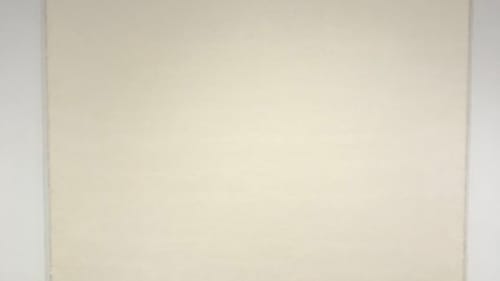Stay in the Loop
BSR publishes on a weekly schedule, with an email newsletter every Wednesday and Thursday morning. There’s no paywall, and subscribing is always free.
Layered approaches
Larry Becker Contemporary Art presents 'Karen Baumeister / Joseph Marioni'

A pair of deceptively similar painters reveal the multiplicity of the monochrome with their very different abstract paintings, now on display at Larry Becker Contemporary Art. Joseph Marioni and Karen Baumeister are, on paper, unlikely candidates for a shared show.
Marioni’s work has been exhibited across the United States and Europe to much acclaim, even drawing the admiration of art critic Michael Fried, who, after seeing Marioni’s work in the 1990s, declared that high Modernist painting would survive the scourge of Minimalism and come out stronger.
Baumeister, by contrast, is not widely known outside Philadelphia. Yet her canvases are in every way as powerful and absorbing as Marioni’s, and perhaps even more inviting.
Similar on the surface
To begin with their similarities, both Marioni and Baumeister are passionately and rigorously devoted to the goal of medium-specific painting. The now-middle-aged Modernist doctrine says a painting should concern itself with paint, not with language or narrative (tools of other art forms), nor with figuration or illusionism (preoccupations that only estrange painting from its essence).
A painting is, irrevocably, paint on a flat canvas. Once this limitation is accepted, the possibilities are endless.
From a distance one might mistake Baumeister’s pieces for Marioni’s, and vice versa — each appears to consist of a single paint color applied more or less evenly across the canvas’s entire surface. Draw closer and one will quickly recognize the error; each painting achieves its ultimate effect through complex layering of two or more shades.
Baumeister, interestingly, acknowledges this method in her titles in a way that Marioni does not. His titles are unequivocal: Dark Violet Painting (2015); Bright Yellow Painting (2018). Hers reflect the dynamic polyphony that animates the paintings to which they refer: Lingering, in Yellows White (2014); Deep Violet Greys to Pink (2013).
Each of the works on display here invites careful and sustained attention. Each sheaths color within color within color to create a particular experience of tension and saturation. Each seeks to occasion a profound experience of light at a particular time and place.
More than most, these canvases benefit from repeated viewings: now on an overcast day, now on a sunny day. Marioni uses the phrase “liquid light” to encapsulate his attitude toward the possibilities of paint and painting, and it is an apt description of Baumeister’s project as well.

Different underneath
However, the most intriguing aspect of considering these two artists side by side is witnessing how aggressively their innate stylistic differences assert themselves. Both have radically pared painting down to the “essential,” but this illustrates that if painting has an essence, it is a mutable one.
Marioni’s paintings are more dazzling but less mysterious than Baumeister’s. He applies several pristinely smooth layers of paint in different colors, sometimes topping them off with a coat so thin it’s translucent. His surfaces have a shellacked look, though this quality comes not from a glaze but from his specially mixed paint.
Around the paintings’ very edges, the stages of this process are visible, with each layer of paint peeking out from the one on top of it. Near the bottom, he might allow gravity to do the work of pulling paint down the canvas, leaving a few drips visible.
This calls attention to the painting's flatness, verticality, and position in space and to the paint's materiality as a substance with weight and viscosity. By using custom-made bowed stretchers for his canvases, Marioni floats his paintings a few inches out from the wall, giving them the appearance of being suspended in air.
Baumeister’s paintings bear the trace of the artist’s hand more forthrightly. Her engagement with the paint feels earthier; thick layers of it gush over the sides of her canvases. By allowing foundational layers to coagulate irregularly, she gives her surfaces a scarred or stroked look. Especially in her “white” paintings, color pulses and lives, like the blue shadow of blood in a vein beneath pale skin.
The paintings on display here are Baumeister’s last; she died in 2015 at just 52. Through Larry Becker and his co-gallerist Heidi Nivling, she met Marioni while still a student at the Pennsylvania Academy of the Fine Arts, and they became mutual admirers and friends.
Marioni suggested he and Baumeister split the billing for this show, and it was an inspired idea. Their obvious kinship makes them a potent combo. But their divergent sensibilities contribute most toward an appreciation of the other’s work, and toward an appreciation of their adored, inexhaustible medium.
What, When, Where
Karen Baumeister / Joseph Marioni. Through June 30, 2018, at Larry Becker Contemporary Art, 43 N. Second Street, Philadelphia. 215-925-5389 or artnet.com/galleries/larry-becker-contemporary-art.
Sign up for our newsletter
All of the week's new articles, all in one place. Sign up for the free weekly BSR newsletters, and don't miss a conversation.

 Jessica Rizzo
Jessica Rizzo